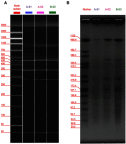Whole genome analysis reveals new insights into the molecular characteristics of Clostridioides difficile NAP1/BI/027/ST1 clinical isolates in the People's Republic of China
- PMID: 31308704
- PMCID: PMC6613002
- DOI: 10.2147/IDR.S203238
Whole genome analysis reveals new insights into the molecular characteristics of Clostridioides difficile NAP1/BI/027/ST1 clinical isolates in the People's Republic of China
Abstract
Background: The epidemic new strain NAP1/BI/027/ST-1 of Clostridioides difficile (C. difficile) causes more severe coliti and a higher mortality rate than historical strains. However, C. difficile NAP1/BI/027/ST-1 (C. difficile RT027) infections have been rarely reported in Asia, particularly in China. Purpose: The objective of this study was to strengthen the understanding of the molecular characterizations of C. difficile RT027 in China. Patients and methods: Two C. difficile NAP1/BI/027/ST-1 were detected from two patients, and no additional isolates were found. Whole genome sequencing (WGS) was used to characterize two C. difficile RT027 isolates and control strain CD6 (from Hong Kong), and comparative genomic analysis was performed to compare genomic differences between seven isolates from Mainland China, CD6, and 10 isolates from North America and Europe. Results: The comparative genomic analysis revealed that isolates obtained from Mainlan China were outside of the two epidemic lineages, FQR1 and FQR2, and might have decreased virulence and transmissibility for outbreak. Furthermore, unique SNP mutations were detected in isolates obtained from Mainland China, which may affect the biological function of C. difficile. Conclusion: We speculate that C. difficile RT027 isolates in Mainland China may have different features, compared to those in North America and Europe.
Keywords: Clostridioides difficile infection; People's Republic of China; multilocus sequence typing; whole genome sequencing.
Conflict of interest statement
The authors report no conflicts of interest in this work.
Figures



Similar articles
-
Origin, genomic diversity and microevolution of the Clostridium difficile B1/NAP1/RT027/ST01 strain in Costa Rica, Chile, Honduras and Mexico.Microb Genom. 2020 May;6(5):e000355. doi: 10.1099/mgen.0.000355. Epub 2020 Mar 16. Microb Genom. 2020. PMID: 32176604 Free PMC article.
-
Virulence and genomic diversity among clinical isolates of ST1 (BI/NAP1/027) Clostridioides difficile.Cell Rep. 2023 Aug 29;42(8):112861. doi: 10.1016/j.celrep.2023.112861. Epub 2023 Jul 30. Cell Rep. 2023. PMID: 37523264 Free PMC article.
-
Virulence and genomic diversity among clinical isolates of ST1 (BI/NAP1/027) Clostridioides difficile.bioRxiv [Preprint]. 2023 Jan 12:2023.01.12.523823. doi: 10.1101/2023.01.12.523823. bioRxiv. 2023. Update in: Cell Rep. 2023 Aug 29;42(8):112861. doi: 10.1016/j.celrep.2023.112861. PMID: 36711955 Free PMC article. Updated. Preprint.
-
Development and Implementation of Whole Genome Sequencing-Based Typing Schemes for Clostridioides difficile.Front Public Health. 2019 Oct 24;7:309. doi: 10.3389/fpubh.2019.00309. eCollection 2019. Front Public Health. 2019. PMID: 31709221 Free PMC article. Review.
-
Clostridioides Difficile in Latin America: An Epidemiological Overview.Curr Microbiol. 2023 Sep 28;80(11):357. doi: 10.1007/s00284-023-03475-x. Curr Microbiol. 2023. PMID: 37768473 Review.
Cited by
-
Molecular Epidemiology and Antimicrobial Resistance of Clostridioides difficile in Hospitalized Patients From Mexico.Front Microbiol. 2022 Mar 10;12:787451. doi: 10.3389/fmicb.2021.787451. eCollection 2021. Front Microbiol. 2022. PMID: 35360652 Free PMC article.
-
Community-acquired fulminant Clostridioides (Clostridium) difficile infection by ribotype 027 isolate in Japan: a case report.Surg Case Rep. 2021 Jun 8;7(1):137. doi: 10.1186/s40792-021-01220-9. Surg Case Rep. 2021. PMID: 34101061 Free PMC article.
-
Comparative genomic and transmission analysis of Clostridioides difficile between environmental, animal, and clinical sources in China.Emerg Microbes Infect. 2021 Dec;10(1):2244-2255. doi: 10.1080/22221751.2021.2005453. Emerg Microbes Infect. 2021. PMID: 34756150 Free PMC article.
References
-
- Brazier JS. Typing of Clostridium difficile. Clin Microbiol Infect. 2001;7(8):428–431. - PubMed
LinkOut - more resources
Full Text Sources
Miscellaneous

